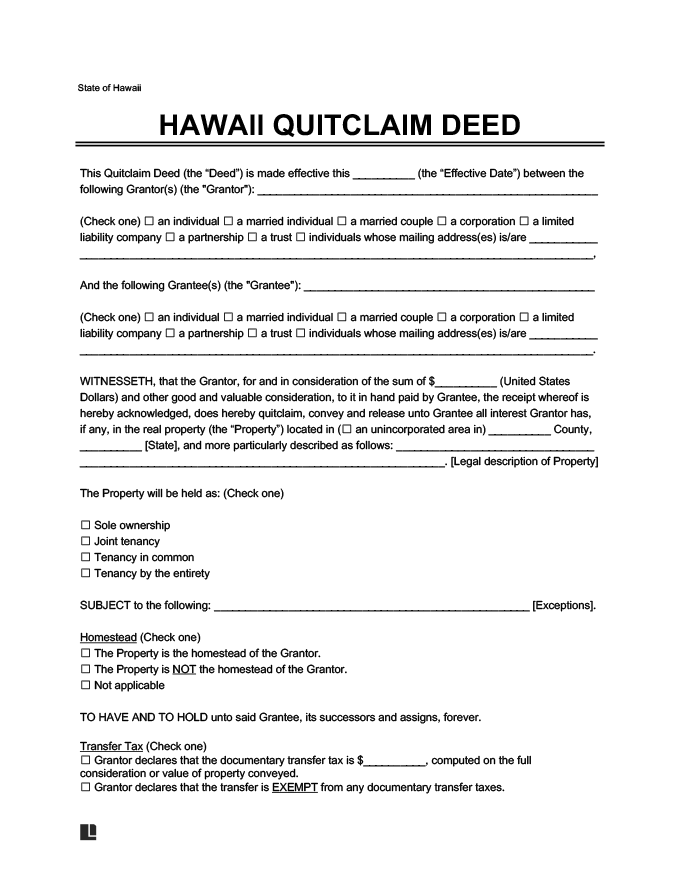Hawaiians can transfer property through several different types of deeds, each offering different levels of promises about the quality of the current property owner’s title. One type of deed, known as a quitclaim, offers no such guarantees.
For this reason, quitclaim deeds are usually only used by people who are close to one another. Friends or family members transferring property can benefit from the less stringent regulations and lower-complexity processes these deeds involve.
Legal Framework
Quitclaim deed requirements are established by Hawaii Revised Statutes Title 28, Chapter 502 (Bureau of Conveyances; Recording).
Legal Description
- Generally, a legal description of a property should contain unique descriptors about its location that go beyond the street address.
- The state considers the property’s tax map number a widely accepted descriptor.
Signing
- Haw. Rev. Stat. § 502-31, Haw. Rev. Stat. § 502-41, and Haw. Rev. Stat. § 502-42 describe the signatures required for a quitclaim deed to be considered legally valid.
- They establish that a deed must be signed by the grantor and acknowledged by a notary public.
Terminology
- There is no specific form for quitclaim deeds included within the statutes; thus, no state-specific language is necessary.
- Like many other states, most quitclaim deeds indicate that the current owner (or grantor) “remises, releases, and forever quitclaims their interest” to the new owner or “grantee.”
Additional Documents
The deed must be accompanied by three different documents:
- A conveyance tax certificate, per Haw. Rev. Stat. § 247-6(a)(b). This is either Form P-64A for those who have to pay the tax or Form P-64B for those exempt from the tax.
- A Real Estate Disclosure Statement, per Haw. Rev. Stat. § 508D-5.
- A Certificate of Good Standing – only if the grantor is a business entity using the state’s land court system for recordation.
Filing
- Different from most other states that handle recordation at the county or town level, Hawaii centralizes all of its land records at the state level through the Honolulu Bureau of Conveyances.
- Once prepared, all deeds must be filed there.
Validity Requirements
The state requires uniform formatting for all deeds in order to assist in document processing procedures. These requirements, described in Haw. Rev. Stat. § 502-31(c)(e), indicate that the:
- Paper size must be at most 8.5 x 11 (letter size).
- Font size must be at least 10.
- Text color must be dark.
- First page must have a 3.5-inch margin at the top.
- Pages must have only single-sided print.
- Pages must be numbered.
- Pages must be fastened by a single staple in the top left corner.
- Pages must not be highlighted.
- Language within the document cannot suggest warranty of title.
Content Requirements
There are two sets of content requirements to follow – one for the first page and one for the rest of the content. On the first page, the document should include:
- The grantor and grantee’s identifying information.
- Labels in the top margin reading “Land Record” on the left side and “Regular System” on the right side.
- Directly below the margin, a return name and address.
- The title “Quitclaim Deed.”
- The property’s tax map number (if available).
Throughout the remainder of the document, content requirements include:
- The grantee’s marital status and their spouse’s name, if applicable (Haw. Rev. Stat. § 501-105(a)).
- The taxpayer’s name and mailing address.
- The property’s address.
- A legal description of the property.
- A granting clause that describes the nature of the transfer.
- A clear statement within the granting clause that the grantor offers no covenants or warranties of title, which can be implied by the use of the word “quitclaim.”
- Whether the property is being transferred to one or more people.
- The property’s homestead status.
- The transferring owner’s notarized signature.
Quitclaim Deeds vs. Other Property Transfer Methods
| Quitclaim Deed | Offers no warranty of title to the grantee. For this reason, if any issue of ownership comes to light, the grantee must defend their right to own the property and cannot sue the grantor for damages. |
| General Warranty Deed | Offers the most extensive warranty of title to the grantee. This type of deed makes the grantor responsible for defending property ownership against issues occurring over the full time the property has existed. |
| Special Warranty Deed | Provides some warranty of title to the grantee. With this type of deed, the grantor must defend the property against any title issues that may arise related to their time of ownership. |
| Life Estate Deed | This type of deed gives the grantor, or “life tenant,” ownership of the property during life and transfers their interest, or “remainder,” to one or more beneficiaries upon death. In this case, the grantee must be included in property decisions. |
| Title Insurance | Since title issues can be costly, Hawaiian grantees who are transferred property through deeds with less title security may decide to pursue legal protection of their ownership in other ways, like obtaining title insurance. |
| Transfer on Death Deed (TODD) | A form of estate planning, grants property ownership to one or more beneficiaries upon a grantor’s death. In this case, the grantor holds full authority to make property decisions or change their mind at any time. |
